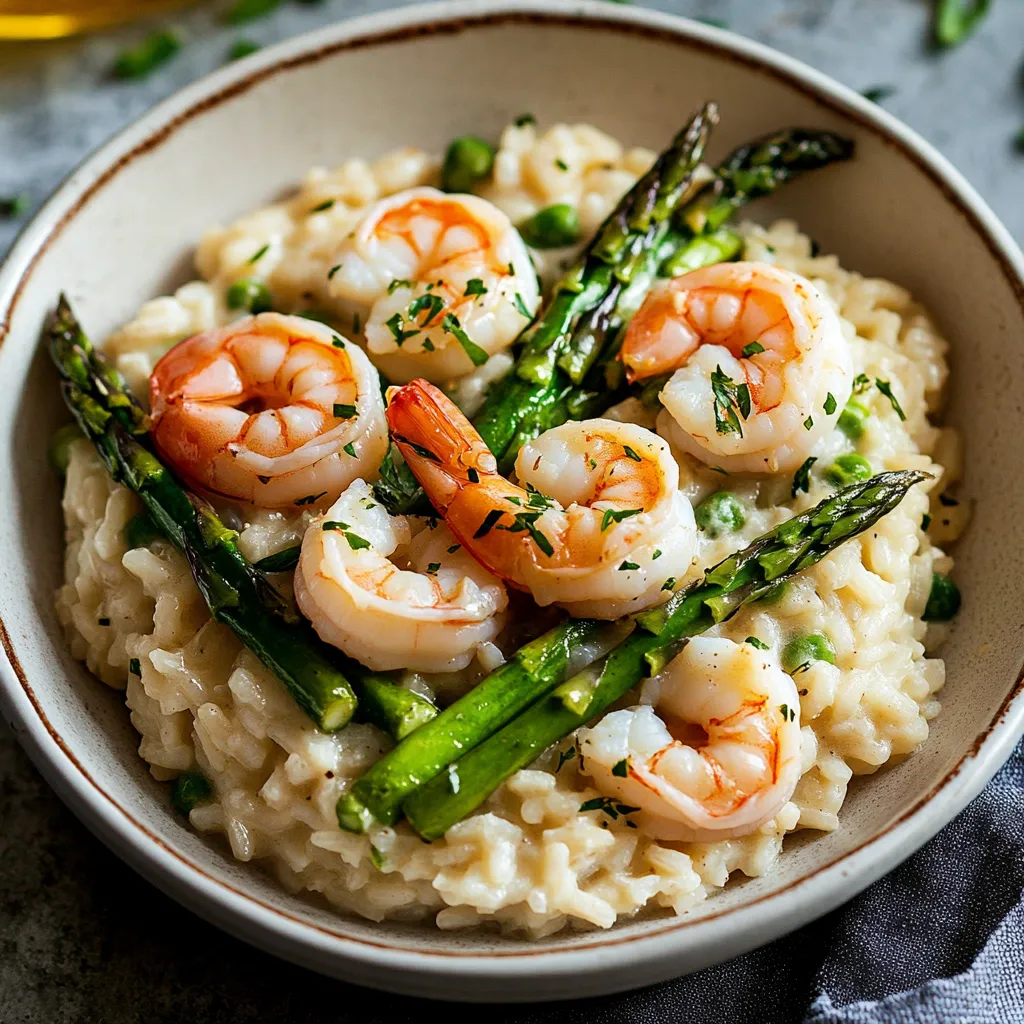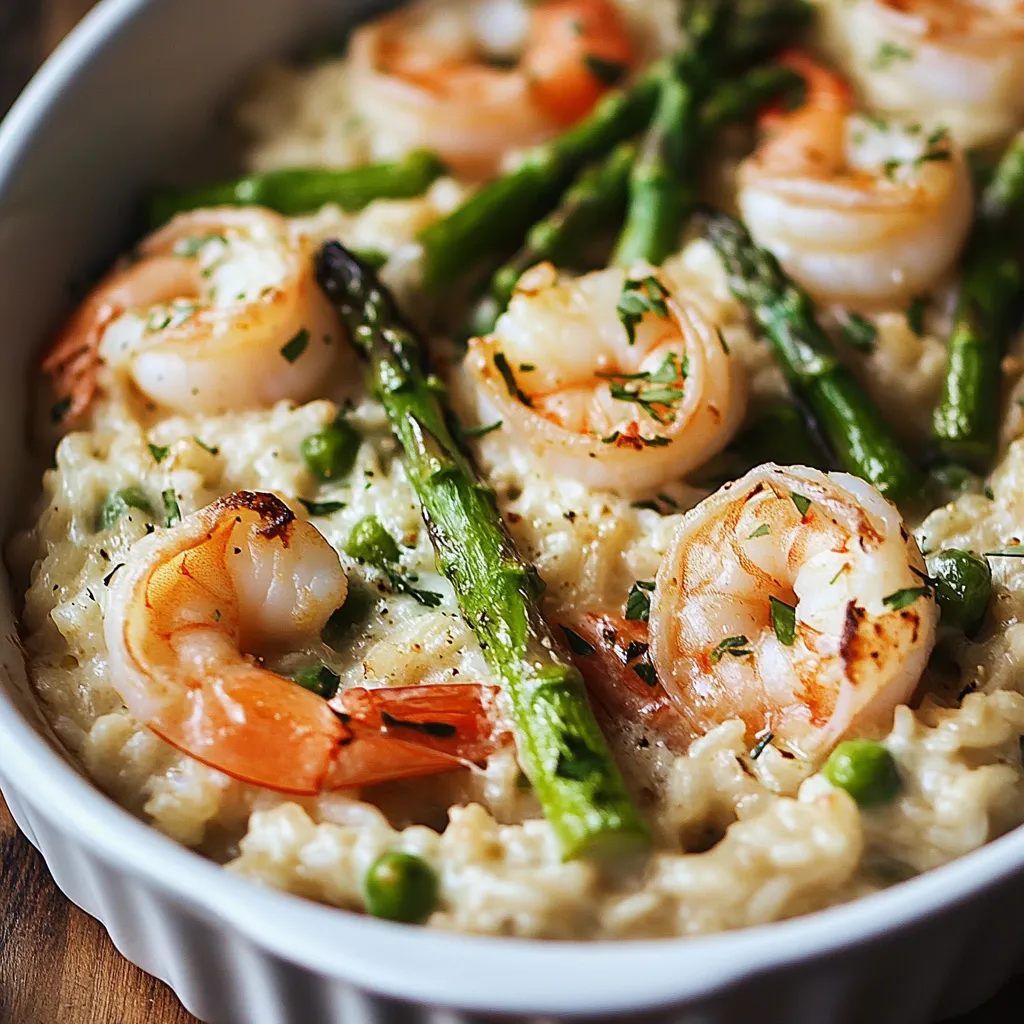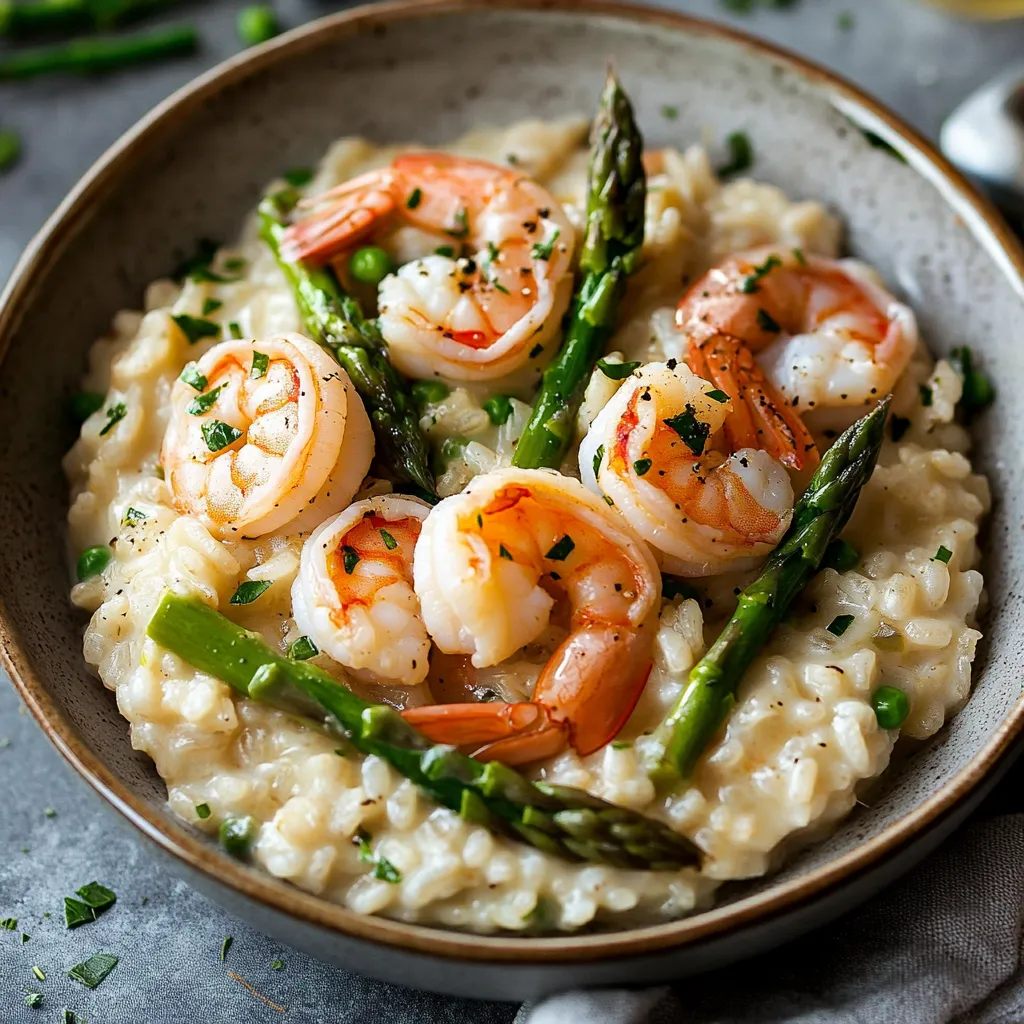 Pin it
Pin it
This rich, creamy shrimp and asparagus risotto transforms simple ingredients into a restaurant-quality meal right in your own kitchen. The combination of tender arborio rice, succulent jumbo shrimp, and fresh asparagus creates a luxurious dish that's perfect for spring entertaining or a special weeknight dinner.
I first made this risotto for my husband on our anniversary when we couldn't get a reservation at our favorite Italian restaurant. Now it's become our tradition to make this dish together on special occasions, slowly stirring and sipping wine as we cook.
Ingredients
- Arborio rice: The specific starch content creates that signature creamy texture essential for authentic risotto
- Jumbo shrimp: 16/20 count ensures meaty large pieces that become the star of the dish
- Fresh asparagus: Choose bright green stalks with tightly closed tips for the best flavor and texture
- Chicken stock: Provides the foundation of flavor homemade is best but high quality store bought works well
- Dry white wine: Adds acidity and depth sauvignon blanc or pinot grigio work perfectly
- Shallot: Milder and more elegant than onion giving a subtle aromatic base
- Garlic: Fresh minced cloves provide essential Italian flavor
- Butter: Creates richness and helps toast the rice for deeper flavor
- Parmesan cheese: Freshly grated provides the perfect salty finish and enhances creaminess
Step-by-Step Instructions
- Prepare the stock:
- Heat chicken stock to a gentle boil then keep covered and warm throughout the cooking process. This critical step ensures the rice cooks evenly as hot stock maintains the perfect cooking temperature when added to the risotto.
- Create the flavor base:
- Melt butter until it begins to foam then add finely minced shallot cooking until translucent but not browned about 2 to 3 minutes. Add minced garlic and cook just until fragrant approximately 1 minute stirring constantly to prevent burning which would create bitterness.
- Toast the rice:
- Add arborio rice to the shallot mixture and stir continuously to coat each grain in butter. Continue cooking for exactly 1 minute which allows the rice to toast slightly enhancing its nutty flavor while creating a protective barrier that helps the grains release starch slowly.
- Begin the liquid additions:
- Pour in wine and notice the sizzle as it hits the hot pan. Stir continuously in a gentle figure eight pattern until the wine is almost completely absorbed. This first liquid builds incredible flavor into the foundation of your risotto.
- Add stock gradually:
- Ladle about half a cup of hot stock into the rice maintaining medium heat. Stir in a slow relaxed motion until the liquid is nearly absorbed but the rice still looks slightly wet. Continue this process one ladle at a time allowing each addition to be mostly absorbed before adding the next.
- Incorporate the vegetables:
- When approximately four ladles of stock remain add the asparagus pieces directly to the risotto. The timing ensures the asparagus cooks just enough to become tender but retains its bright color and slight crispness perfectly complementing the creamy rice.
- Add the shrimp:
- With about two ladles of stock remaining introduce the peeled shrimp to the mixture. The residual cooking time will ensure the shrimp cooks through completely while remaining juicy and tender. If using precooked shrimp add with just one ladle remaining.
- Finish with cheese:
- Once the rice is tender but still has slight resistance when bitten remove from heat completely. Immediately stir in freshly grated parmesan allowing it to melt into the hot risotto creating an even creamier texture. Season thoughtfully with salt and pepper to taste.
 Pin it
Pin it
My favorite moment making this dish was when my Italian grandmother finally approved of my risotto technique after years of telling me I was rushing the process. She taught me that patience is the secret ingredient that transforms this from good to exceptional.
Perfect Pairings
This elegant risotto deserves thoughtful accompaniments. A simple arugula salad with lemon vinaigrette provides a peppery contrast to the rich risotto. The acidity cuts through the creaminess creating balance. For wine nothing complements this dish better than the same dry white you used in cooking especially a crisp Pinot Grigio or unoaked Chardonnay.
Storage and Reheating
While risotto is best enjoyed immediately after preparation it can be stored in an airtight container in the refrigerator for up to two days. To reheat add a splash of chicken stock or water before warming gently on the stovetop over medium low heat. Stir frequently to bring back the creamy consistency. Avoid microwave reheating which can make the shrimp rubbery and the texture inconsistent.
Ingredient Substitutions
Dont have all the exact ingredients? Dont worry. Carnaroli rice works beautifully in place of arborio for an even creamier result. Vegetable stock can replace chicken stock for a vegetarian version just add extra seasoning. No fresh asparagus? Frozen peas added in the last five minutes create a similar spring feel. For a dairy free option substitute olive oil for butter and omit the cheese finishing with a squeeze of lemon instead.
 Pin it
Pin it
This recipe proves that with a little patience and love you can create a dish rivaling any restaurant — right in your own kitchen.
Frequently Asked Questions
- → What type of rice should I use for risotto?
Arborio rice is the traditional choice for risotto because of its high starch content, which creates the creamy texture characteristic of risotto. Other Italian short-grain rice varieties like Carnaroli or Vialone Nano also work well. Don't substitute with long-grain rice as it won't produce the proper texture.
- → Why do I need to stir risotto continuously?
Continuous stirring serves two important purposes: it helps release the starch from the rice grains (creating the creamy texture) and prevents the rice from sticking to the bottom of the pan and burning. While you don't need to stir frantically, consistent, gentle stirring throughout the cooking process is essential for proper risotto technique.
- → Can I make this risotto ahead of time?
Risotto is best enjoyed immediately after cooking when the texture is perfectly creamy. However, you can prepare it partially in advance by cooking it until it's about 75% done, then cooling and refrigerating. When ready to serve, bring it back to temperature by adding more hot stock and finishing the cooking process with the shrimp and asparagus.
- → What can I substitute for white wine in risotto?
If you prefer not to use wine, you can substitute with additional chicken stock plus 1-2 teaspoons of lemon juice or white wine vinegar to provide the acidity that wine would normally contribute. For a non-alcoholic alternative that maintains some flavor complexity, you could use a splash of white grape juice with a touch of vinegar.
- → How do I know when my risotto is done?
Perfectly cooked risotto should be al dente - tender but with a slight firmness in the center of each grain. The overall texture should be creamy and flowing, not stiff or sticky. Italians describe proper risotto as 'all'onda' (wavy) - it should spread slightly when served on a plate but not be soupy. Taste as you go toward the end of cooking to achieve your preferred texture.
- → Can I use frozen shrimp for this risotto?
Yes, frozen shrimp works well in this dish. Just be sure to fully thaw and pat them dry before adding to the risotto. Using frozen shrimp is often more economical and convenient than fresh, and the quality is usually excellent since most shrimp is frozen shortly after being caught.
